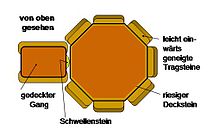Megalithic systems in Hørret Skov
The megalithic facilities in Hørret Skov (Forest of Hørret) are located north of the Mårsleter district of Langballe and west of the area of the Århus Golf Club in the Jutland part of Denmark . They were excavated from the nearby Moesgård Museum in 1976/77 . They originated between 3500 and 2800 BC. And are megalithic systems of the funnel beaker culture (TBK). Neolithic monuments are an expression of the culture and ideology of Neolithic societies. Their origin and function are considered to be the hallmarks of social development.
Three of what were once five Neolithic megalithic structures have been preserved as protected monuments. One is only preserved in remnants (Appendix 2), but worked up through the excavation; Annex 5 has been completely removed. In the forest there is also a long hill that has not been investigated .
Attachment 1
At the north-eastern edge of the forest is a dolmen remnant , consisting of five stones, which originally lay in a north-south oriented barren bed . The small chamber, the capstone of which is missing, has its entrance to the east. The ceramic finds from the disturbed chamber floor date the system to the megalithic phase of the funnel beaker culture (TBK - 3500–2800 BC). An ax of the single grave culture comes from a subsequent burial . A small stone circle and a Röse with a stone box was during the Iron Age set to the hill.
Annex 2
In the western part of the forest, a chamber in the round hill was destroyed a long time ago by the construction of a forest road. The remains of the hill and the stones of the Ganges (on the east side) are still preserved on site. The excavation revealed the footprints of six ovally arranged supporting stones. A threshold stone marked the transition between the chamber and the corridor . The chamber (presumably a polygonal pole ) has been removed. The hill, which is bordered by curb stones about 70 cm high and made of reading stones , has a diameter of ten meters. Part of the chamber floor made of burnt flint was preserved below the forest road. The remains of the grave goods consisted of a roughly worked stone ax, a flint blade and a characteristically decorated one; shattered ceramics of the funnel beaker culture. Similar shards lay in the corridor.
To the south of the hill there are three building stones that were erected on the basis of the ceramic finds during the Iron Age.
Annex 3
Near the south-eastern edge of a wood, a northeast-southwest oriented barrow of about 18 × 7 m with the remains of a stone deck loose passage grave with a two-meter-long passage. The passage grave is a form of Neolithic megalithic systems , which consists of a chamber and a structurally separated, lateral passage. This form is primarily found in Denmark, Germany and Scandinavia, as well as occasionally in France and the Netherlands. The megalithic bed was restored after the excavation and is almost completely enclosed with curbs. Only a few grave goods were found in the chamber, including tubular amber beads . In front of the mouth of the passage, in the middle of the east side, a lot of broken earthenware was found.
Appendix 4
According to the finds, there is a stone box of the individual grave culture (2800-2400 BC) from the late Neolithic in the middle of a hill . The 0.5 m deep stone box measures around 3.0 × 1.0 m. All side stones and two of the once four cap stones have been preserved. A flint vessel and arrowhead were found.
See also
literature
- Anna Lindebo Leth: Fortidsminder i Århus-området. En tur guide. Århus Amt, Højbjerg 1993, ISBN 87-7295-757-3 , pp. 9-11.
Individual evidence
- ^ Johannes Müller : Neolithic Monuments and Neolithic Societies. In: Hans-Jürgen Beier , Erich Claßen, Thomas Doppler, Britta Ramminger (eds.): Varia neolithica VI. Neolithic Monuments and Neolithic Societies. Contributions from the meeting of the Neolithic Working Group during the annual meeting of the North-West German Association for Ancient Research in Schleswig, 9. – 10. October 2007 (= contributions to the prehistory and early history of Central Europe. Vol. 56). Beier & Beran, Langenweißbach 2009, ISBN 978-3-941171-28-2 , pp. 7-16, here p. 15.
Web links
Coordinates: 56 ° 4 ′ 56.8 " N , 10 ° 11 ′ 48.3" E

